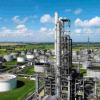I'm posting this to see if anyone has experience performing calculations for the subject application.
I am charged with validating the venting requirements for two refrigerated liquid ammonia tanks. The tanks have a design pressure of 1.0 psig and store saturated liquid ammonia at a temperature of approx. -27 F. The tanks are located on the Gulf Coast, and the client has reported that the PVSV's have vented during hurricane events.
I have not done vent calculations of this type, and so I have reasoned through my own methodology and want to be sure I am thinking about it right.
The pressure rating, of course, is relative to atmosphere, and so a drop in pressure coincident with a hurricane would result in a similar drop in the maximum absolute pressure in the tank. If the atmospheric pressure in this example drops to less than 1 psi below the vapor pressure of the tank contents, then liquid in the tank would boil, and the rate of vaporization would have to be accomodated by the PVSV's.
I've calculated this doing a heat balance based on the tank inventory, liquid heat capacity, and heat of vaporization. The vaporization rate, in SCFH, would also depend on the rate of decrease in atmospheric pressure, which in turn is based on the characteristics of the storm (i.e., pressure profile, minimum pressure in the storm, and forward speed of the storm.)
My calculation, which is based on a Hurricane Andrew type storm (probably a worst case in terms of pressure profile) came up with some pretty big vent rates, depending on how much is in that tank when the storm hits.
I'd be interested to hear from anyone else who has come across this type of problem to share their approach, or if not, any commentary on the soundmess of how I did it.
Regards,
Mike

 FB
FB










